2007 ISUZU KB P190 engine
[x] Cancel search: enginePage 1164 of 6020
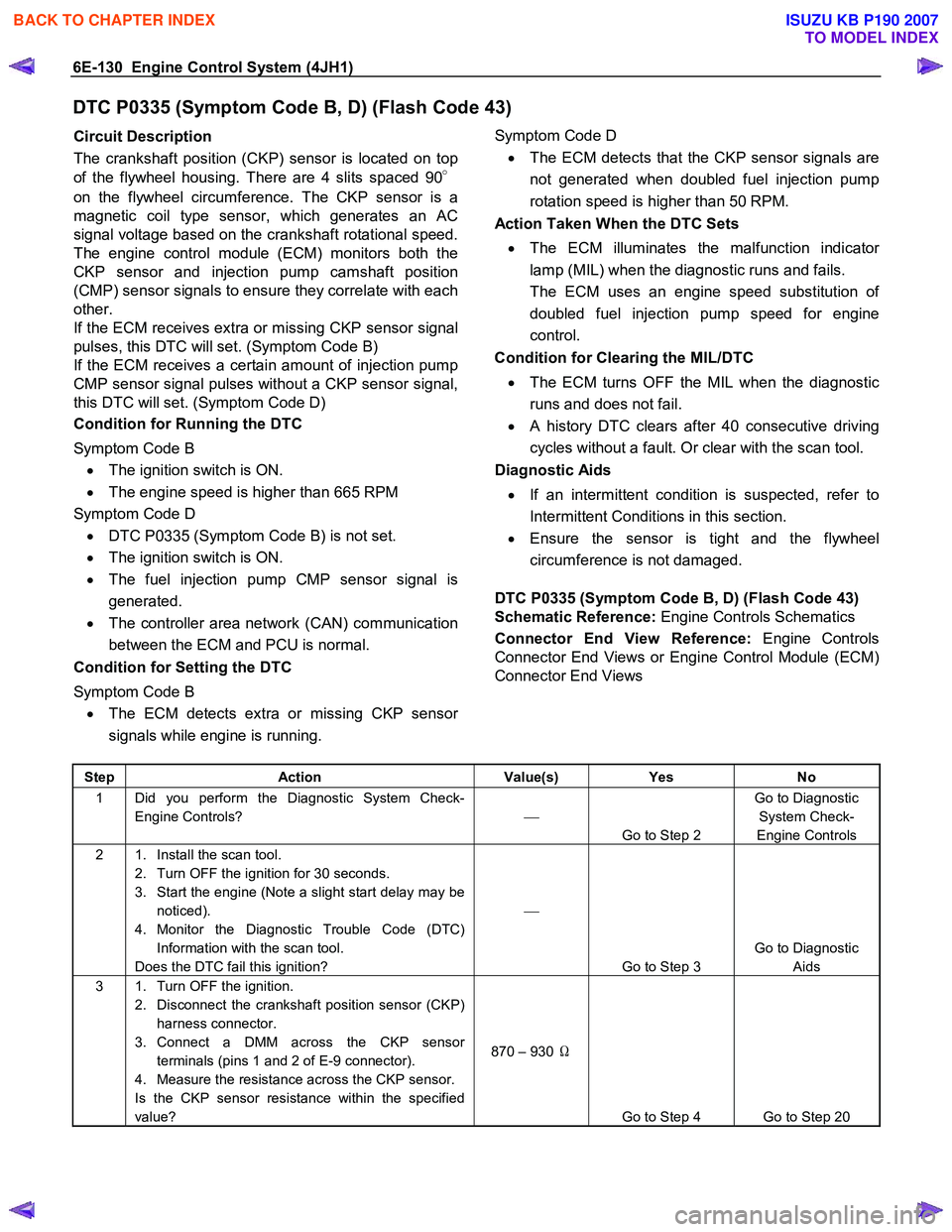
6E-130 Engine Control System (4JH1)
DTC P0335 (Symptom Code B, D) (Flash Code 43)
Circuit Description
The crankshaft position (CKP) sensor is located on top
of the flywheel housing. There are 4 slits spaced 90 °
on the flywheel circumference. The CKP sensor is a
magnetic coil type sensor, which generates an AC
signal voltage based on the crankshaft rotational speed.
The engine control module (ECM) monitors both the
CKP sensor and injection pump camshaft position
(CMP) sensor signals to ensure they correlate with each
other.
If the ECM receives extra or missing CKP sensor signal
pulses, this DTC will set. (Symptom Code B)
If the ECM receives a certain amount of injection pump
CMP sensor signal pulses without a CKP sensor signal,
this DTC will set. (Symptom Code D)
Condition for Running the DTC
Symptom Code B • The ignition switch is ON.
• The engine speed is higher than 665 RPM
Symptom Code D • DTC P0335 (Symptom Code B) is not set.
• The ignition switch is ON.
• The fuel injection pump CMP sensor signal is
generated.
• The controller area network (CAN) communication
between the ECM and PCU is normal.
Condition for Setting the DTC
Symptom Code B • The ECM detects extra or missing CKP senso
r
signals while engine is running.
Symptom Code D
• The ECM detects that the CKP sensor signals are
not generated when doubled fuel injection pump
rotation speed is higher than 50 RPM.
Action Taken When the DTC Sets
• The ECM illuminates the malfunction indicato
r
lamp (MIL) when the diagnostic runs and fails.
The ECM uses an engine speed substitution o
f
doubled fuel injection pump speed for engine
control.
Condition for Clearing the MIL/DTC
• The ECM turns OFF the MIL when the diagnostic
runs and does not fail.
• A history DTC clears after 40 consecutive driving
cycles without a fault. Or clear with the scan tool.
Diagnostic Aids
• If an intermittent condition is suspected, refer to
Intermittent Conditions in this section.
• Ensure the sensor is tight and the flywheel
circumference is not damaged.
DTC P0335 (Symptom Code B, D) (Flash Code 43)
Schematic Reference: Engine Controls Schematics
Connector End View Reference: Engine Controls
Connector End Views or Engine Control Module (ECM)
Connector End Views
Step Action Value(s) Yes No
1 Did you perform the Diagnostic System Check-
Engine Controls?
Go to Step 2 Go to Diagnostic
System Check-
Engine Controls
2 1. Install the scan tool. 2. Turn OFF the ignition for 30 seconds.
3. Start the engine (Note a slight start delay may be noticed).
4. Monitor the Diagnostic Trouble Code (DTC) Information with the scan tool.
Does the DTC fail this ignition?
Go to Step 3 Go to Diagnostic
Aids
3 1. Turn OFF the ignition. 2. Disconnect the crankshaft position sensor (CKP) harness connector.
3. Connect a DMM across the CKP sensor terminals (pins 1 and 2 of E-9 connector).
4. Measure the resistance across the CKP sensor.
Is the CKP sensor resistance within the specified
value? 870 – 930
Ω
Go to Step 4 Go to Step 20
BACK TO CHAPTER INDEX
TO MODEL INDEX
ISUZU KB P190 2007
Page 1165 of 6020
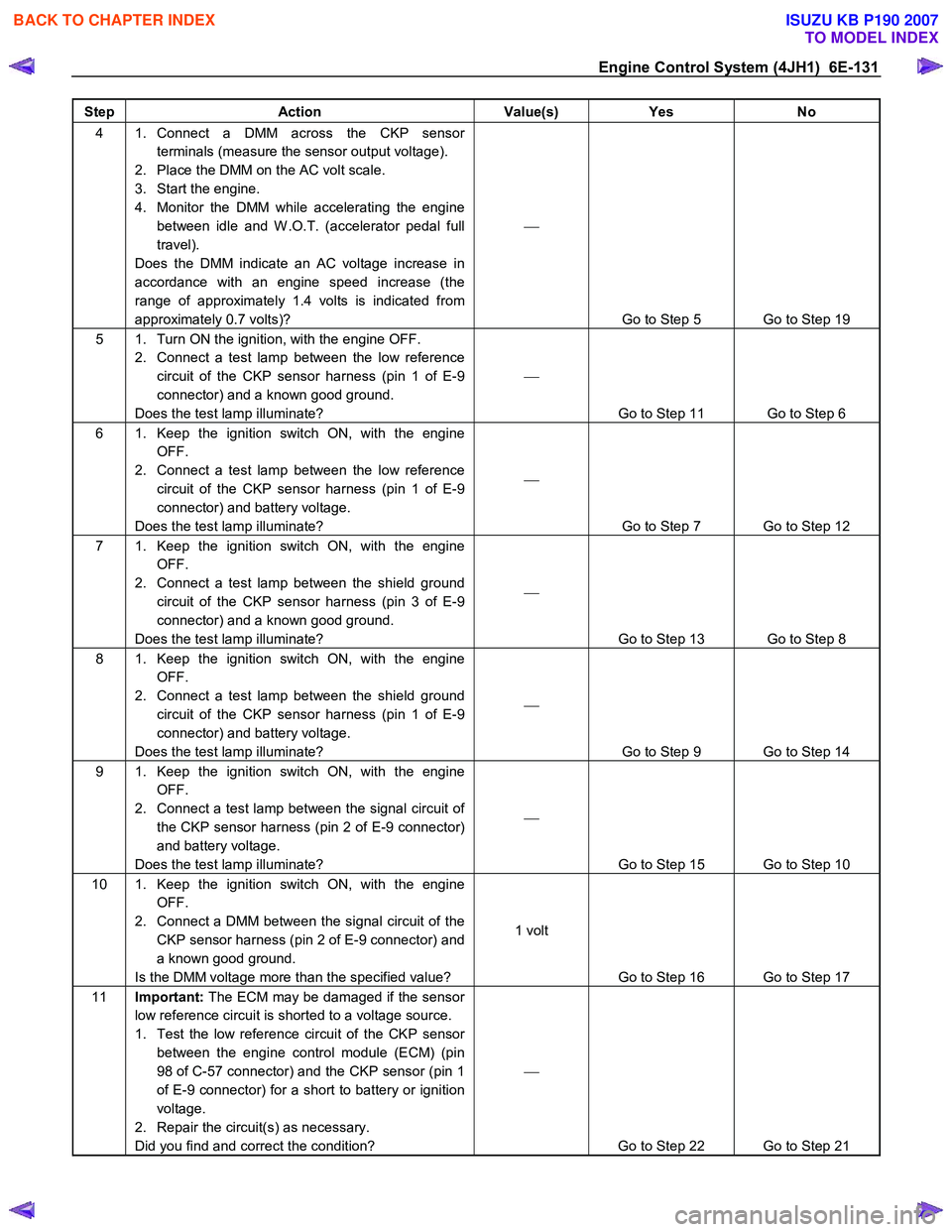
Engine Control System (4JH1) 6E-131
Step Action Value(s) Yes No
4 1. Connect a DMM across the CKP sensor
terminals (measure the sensor output voltage).
2. Place the DMM on the AC volt scale.
3. Start the engine.
4. Monitor the DMM while accelerating the engine between idle and W .O.T. (accelerator pedal full
travel).
Does the DMM indicate an AC voltage increase in
accordance with an engine speed increase (the
range of approximately 1.4 volts is indicated from
approximately 0.7 volts)?
Go to Step 5 Go to Step 19
5 1. Turn ON the ignition, with the engine OFF. 2. Connect a test lamp between the low reference circuit of the CKP sensor harness (pin 1 of E-9
connector) and a known good ground.
Does the test lamp illuminate?
Go to Step 11 Go to Step 6
6 1. Keep the ignition switch ON, with the engine OFF.
2. Connect a test lamp between the low reference circuit of the CKP sensor harness (pin 1 of E-9
connector) and battery voltage.
Does the test lamp illuminate?
Go to Step 7 Go to Step 12
7 1. Keep the ignition switch ON, with the engine OFF.
2. Connect a test lamp between the shield ground circuit of the CKP sensor harness (pin 3 of E-9
connector) and a known good ground.
Does the test lamp illuminate?
Go to Step 13 Go to Step 8
8 1. Keep the ignition switch ON, with the engine OFF.
2. Connect a test lamp between the shield ground circuit of the CKP sensor harness (pin 1 of E-9
connector) and battery voltage.
Does the test lamp illuminate?
Go to Step 9 Go to Step 14
9 1. Keep the ignition switch ON, with the engine OFF.
2. Connect a test lamp between the signal circuit of the CKP sensor harness (pin 2 of E-9 connector)
and battery voltage.
Does the test lamp illuminate?
Go to Step 15 Go to Step 10
10 1. Keep the ignition switch ON, with the engine OFF.
2. Connect a DMM between the signal circuit of the CKP sensor harness (pin 2 of E-9 connector) and
a known good ground.
Is the DMM voltage more than the specified value? 1 volt
Go to Step 16 Go to Step 17
11 Important: The ECM may be damaged if the sensor
low reference circuit is shorted to a voltage source.
1. Test the low reference circuit of the CKP sensor between the engine control module (ECM) (pin
98 of C-57 connector) and the CKP sensor (pin 1
of E-9 connector) for a short to battery or ignition
voltage.
2. Repair the circuit(s) as necessary.
Did you find and correct the condition?
Go to Step 22 Go to Step 21
BACK TO CHAPTER INDEX
TO MODEL INDEX
ISUZU KB P190 2007
Page 1166 of 6020

6E-132 Engine Control System (4JH1)
Step Action Value(s) Yes No
12 1. Test the low reference circuit of the CKP sensor
between the ECM (pin 98 of C-57 connector) and
the CKP sensor (pin 1 of E-9 connector) for an
open circuit or high resistance.
2. Repair the circuit(s) as necessary.
Did you find and correct the condition?
Go to Step 22 Go to Step 18
13 Important: The ECM may be damaged if the sensor
shield ground circuit is shorted to a voltage source.
1. Test the shield ground circuit of the CKP sensor between the ECM (pin 101 of C-57 connector)
and the CKP sensor (pin 3 of E-9 connector) for
a short to battery or ignition voltage.
2. Repair the circuit(s) as necessary.
Did you find and correct the condition?
Go to Step 22 Go to Step 21
14 1. Test the shield ground circuit of the CKP sensor between the ECM (pin 101 of C-57 connector)
and the CKP sensor (pin 3 of E-9 connector) for
an open circuit or high resistance.
2. Repair the circuit(s) as necessary.
Did you find and correct the condition?
Go to Step 22 Go to Step 18
15 1. Test the signal circuit of the CKP sensor between the ECM (pin 90 of C-57 connector) and the CKP
sensor (pin 2 of E-9 connector) for the following
conditions: • A short to ground
• A short to the low reference circuit
• A short to the shield ground
2. Repair the circuit(s) as necessary.
Did you find and correct the condition?
Go to Step 22 Go to Step 21
16 Important: The CKP sensor may be damaged if the
sensor signal circuit is shorted to a voltage source.
1. Test the signal circuit of the CKP sensor between the ECM (pin 90 of C-57 connector) and the CKP
sensor (pin 2 of E-9 connector) for the following
conditions:
• A short to battery or ignition voltage
• A short to any 5 volts reference
2. Repair the circuit(s) as necessary.
Did you find and correct the condition?
Go to Step 22 Go to Step 21
17 1. Turn OFF the ignition. 2. Inspect for an intermittent and for poor connections at the harness connector of the CKP
sensor (pins 1, 2 and 3 of E-9 connector).
3. Repair the connection(s) as necessary.
Did you find and correct the condition?
Go to Step 22 Go to Step 20
18 1. Turn OFF the ignition. 2. Disconnect the ECM harness connector.
3. Inspect for an intermittent and for poor connections on the CKP sensor circuits at the
harness connector of the ECM (pins 90, 98 and
101 of C-57 connector).
4. Repair the connection(s) as necessary.
Did you find and correct the condition?
Go to Step 22 Go to Step 21
BACK TO CHAPTER INDEX
TO MODEL INDEX
ISUZU KB P190 2007
Page 1167 of 6020
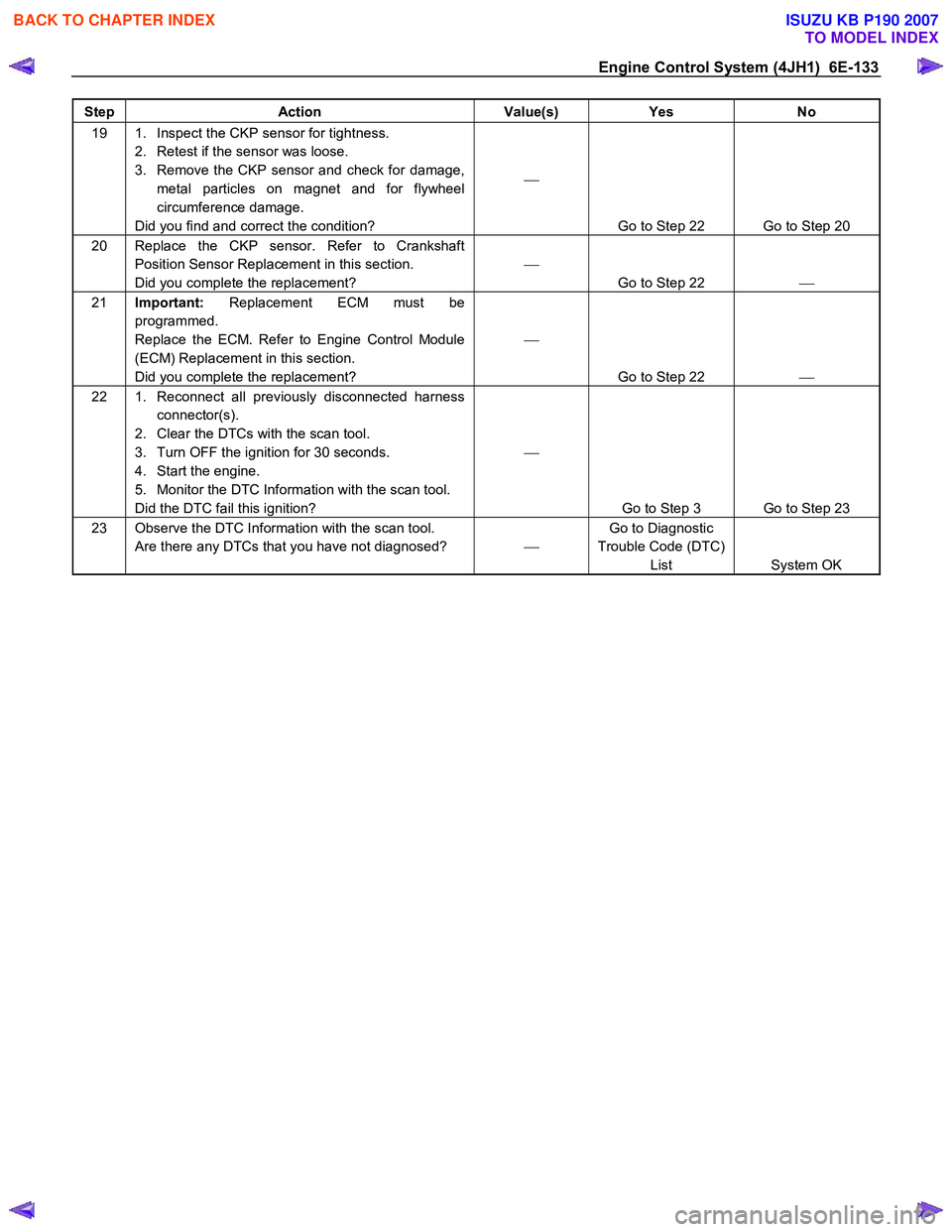
Engine Control System (4JH1) 6E-133
Step Action Value(s) Yes No
19 1. Inspect the CKP sensor for tightness.
2. Retest if the sensor was loose.
3. Remove the CKP sensor and check for damage, metal particles on magnet and for flywheel
circumference damage.
Did you find and correct the condition?
Go to Step 22 Go to Step 20
20 Replace the CKP sensor. Refer to Crankshaft Position Sensor Replacement in this section.
Did you complete the replacement?
Go to Step 22
21 Important: Replacement ECM must be
programmed.
Replace the ECM. Refer to Engine Control Module
(ECM) Replacement in this section.
Did you complete the replacement?
Go to Step 22
22 1. Reconnect all previously disconnected harness
connector(s).
2. Clear the DTCs with the scan tool.
3. Turn OFF the ignition for 30 seconds.
4. Start the engine.
5. Monitor the DTC Information with the scan tool.
Did the DTC fail this ignition?
Go to Step 3 Go to Step 23
23 Observe the DTC Information with the scan tool. Are there any DTCs that you have not diagnosed? Go to Diagnostic
Trouble Code (DTC) List System OK
BACK TO CHAPTER INDEX
TO MODEL INDEX
ISUZU KB P190 2007
Page 1168 of 6020
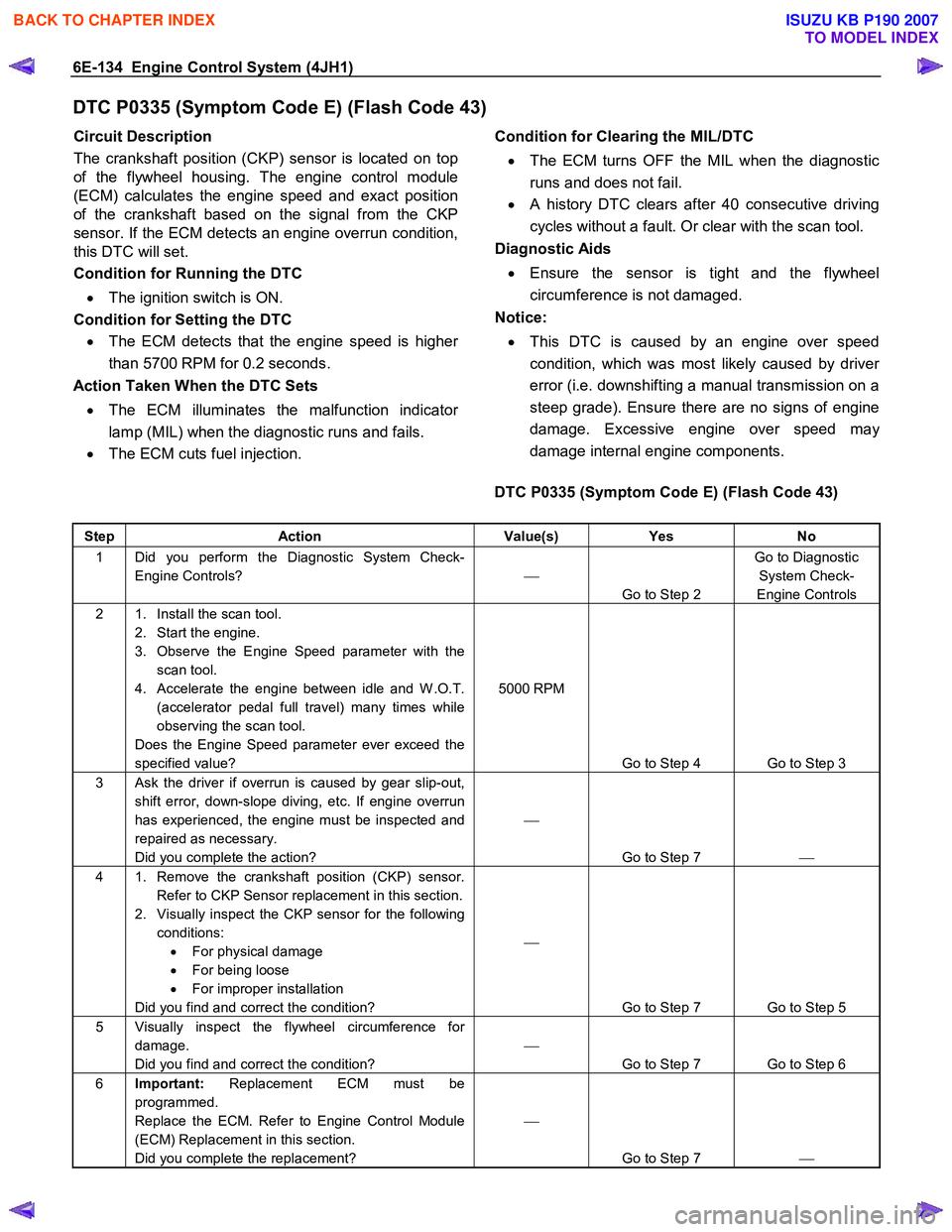
6E-134 Engine Control System (4JH1)
DTC P0335 (Symptom Code E) (Flash Code 43)
Circuit Description
The crankshaft position (CKP) sensor is located on top
of the flywheel housing. The engine control module
(ECM) calculates the engine speed and exact position
of the crankshaft based on the signal from the CKP
sensor. If the ECM detects an engine overrun condition,
this DTC will set.
Condition for Running the DTC
• The ignition switch is ON.
Condition for Setting the DTC • The ECM detects that the engine speed is highe
r
than 5700 RPM for 0.2 seconds.
Action Taken When the DTC Sets
• The ECM illuminates the malfunction indicato
r
lamp (MIL) when the diagnostic runs and fails.
• The ECM cuts fuel injection.
Condition for Clearing the MIL/DTC
• The ECM turns OFF the MIL when the diagnostic
runs and does not fail.
• A history DTC clears after 40 consecutive driving
cycles without a fault. Or clear with the scan tool.
Diagnostic Aids
• Ensure the sensor is tight and the flywheel
circumference is not damaged.
Notice:
• This DTC is caused by an engine over speed
condition, which was most likely caused by drive
r
error (i.e. downshifting a manual transmission on a
steep grade). Ensure there are no signs of engine
damage. Excessive engine over speed ma
y
damage internal engine components.
DTC P0335 (Symptom Code E) (Flash Code 43)
Step Action Value(s) Yes No
1 Did you perform the Diagnostic System Check-
Engine Controls?
Go to Step 2 Go to Diagnostic
System Check-
Engine Controls
2 1. Install the scan tool. 2. Start the engine.
3. Observe the Engine Speed parameter with the scan tool.
4. Accelerate the engine between idle and W .O.T. (accelerator pedal full travel) many times while
observing the scan tool.
Does the Engine Speed parameter ever exceed the
specified value? 5000 RPM
Go to Step 4 Go to Step 3
3 Ask the driver if overrun is caused by gear slip-out, shift error, down-slope diving, etc. If engine overrun
has experienced, the engine must be inspected and
repaired as necessary.
Did you complete the action?
Go to Step 7
4 1. Remove the crankshaft position (CKP) sensor.
Refer to CKP Sensor replacement in this section.
2. Visually inspect the CKP sensor for the following conditions: • For physical damage
• For being loose
• For improper installation
Did you find and correct the condition?
Go to Step 7 Go to Step 5
5 Visually inspect the flywheel circumference for damage.
Did you find and correct the condition?
Go to Step 7 Go to Step 6
6 Important: Replacement ECM must be
programmed.
Replace the ECM. Refer to Engine Control Module
(ECM) Replacement in this section.
Did you complete the replacement?
Go to Step 7
BACK TO CHAPTER INDEX
TO MODEL INDEX
ISUZU KB P190 2007
Page 1169 of 6020
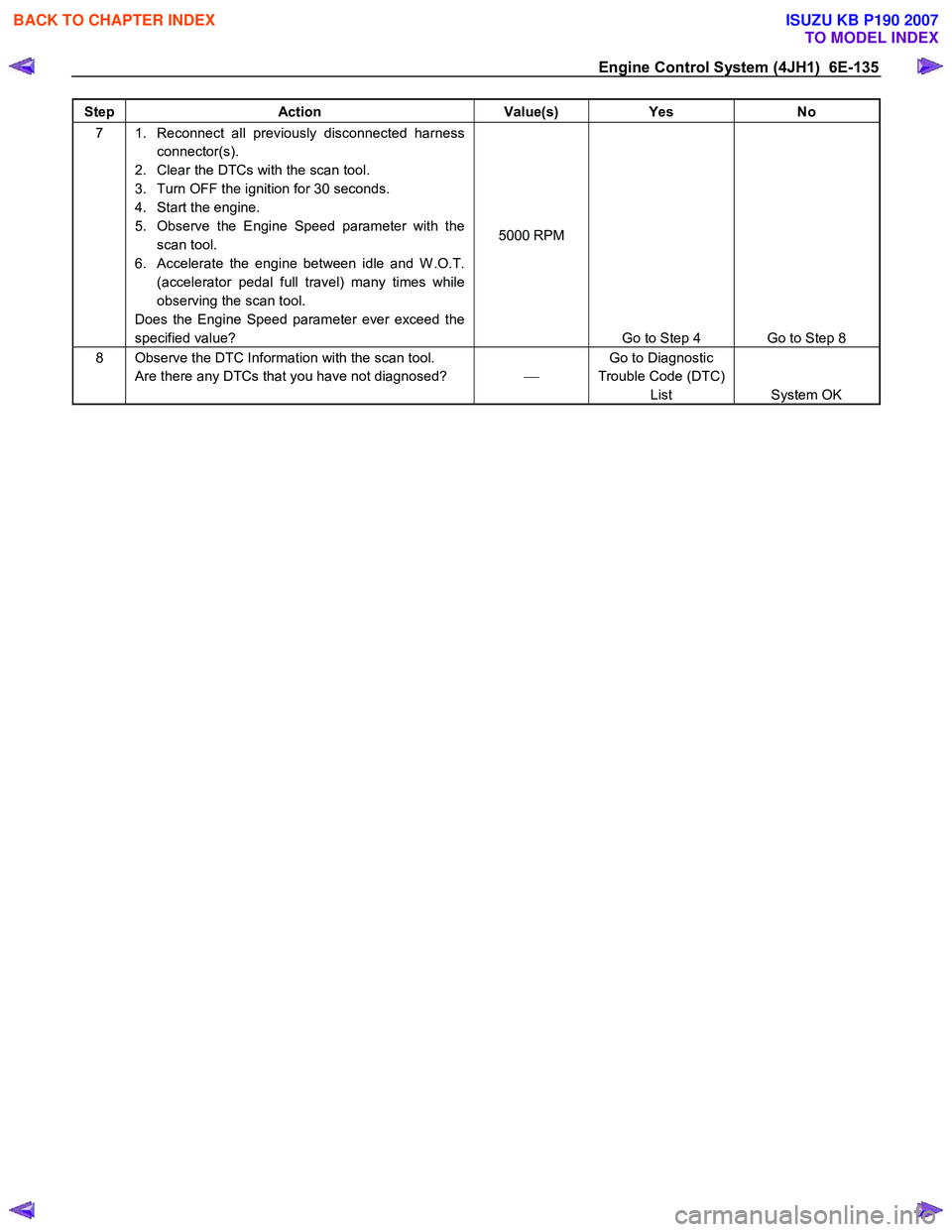
Engine Control System (4JH1) 6E-135
Step Action Value(s) Yes No
7 1. Reconnect all previously disconnected harness
connector(s).
2. Clear the DTCs with the scan tool.
3. Turn OFF the ignition for 30 seconds.
4. Start the engine.
5. Observe the Engine Speed parameter with the scan tool.
6. Accelerate the engine between idle and W .O.T. (accelerator pedal full travel) many times while
observing the scan tool.
Does the Engine Speed parameter ever exceed the
specified value? 5000 RPM
Go to Step 4 Go to Step 8
8 Observe the DTC Information with the scan tool. Are there any DTCs that you have not diagnosed? Go to Diagnostic
Trouble Code (DTC) List System OK
BACK TO CHAPTER INDEX
TO MODEL INDEX
ISUZU KB P190 2007
Page 1170 of 6020
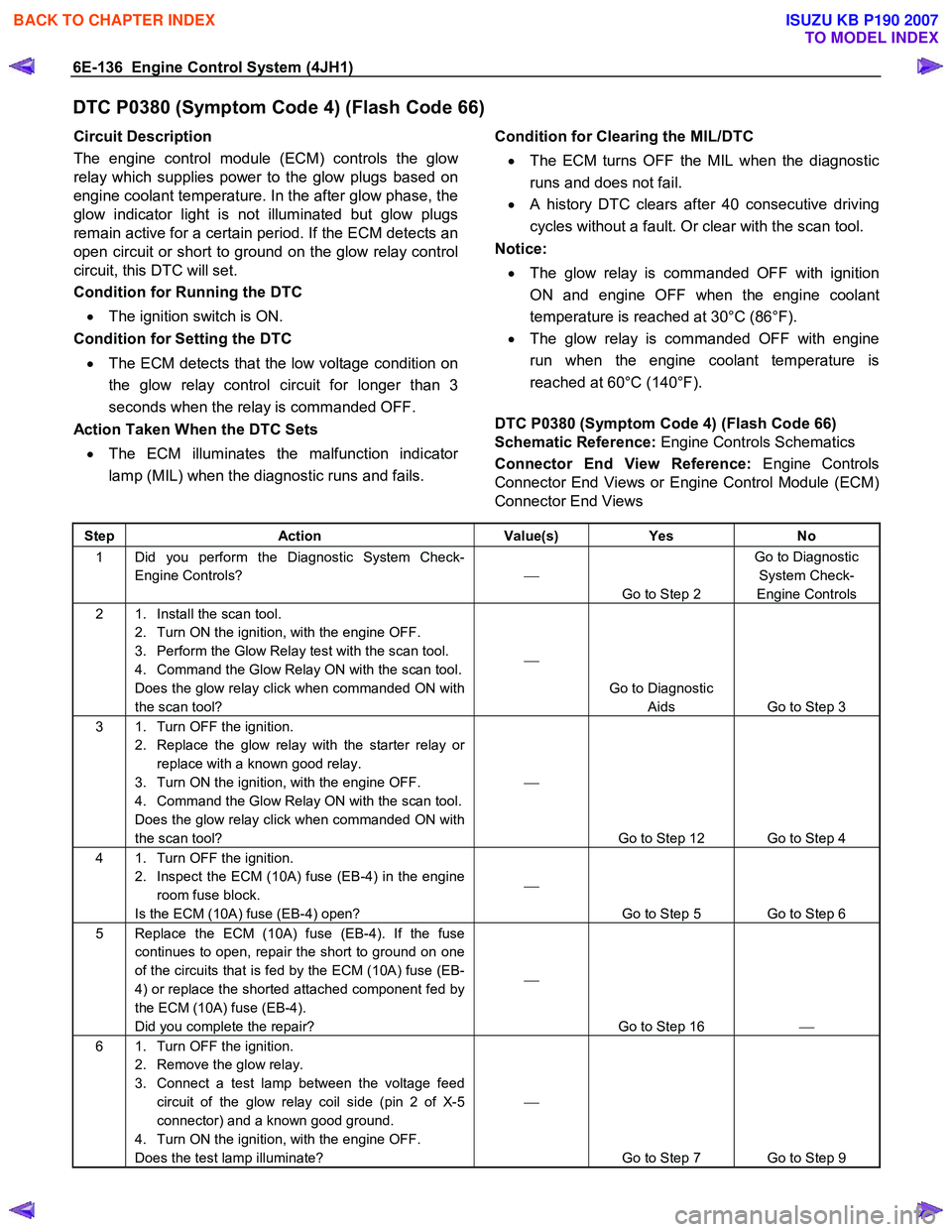
6E-136 Engine Control System (4JH1)
DTC P0380 (Symptom Code 4) (Flash Code 66)
Circuit Description
The engine control module (ECM) controls the glo
w
relay which supplies power to the glow plugs based on
engine coolant temperature. In the after glow phase, the
glow indicator light is not illuminated but glow plugs
remain active for a certain period. If the ECM detects an
open circuit or short to ground on the glow relay control
circuit, this DTC will set.
Condition for Running the DTC
• The ignition switch is ON.
Condition for Setting the DTC
• The ECM detects that the low voltage condition on
the glow relay control circuit for longer than 3
seconds when the relay is commanded OFF.
Action Taken When the DTC Sets
• The ECM illuminates the malfunction indicato
r
lamp (MIL) when the diagnostic runs and fails.
Condition for Clearing the MIL/DTC
• The ECM turns OFF the MIL when the diagnostic
runs and does not fail.
• A history DTC clears after 40 consecutive driving
cycles without a fault. Or clear with the scan tool.
Notice:
• The glow relay is commanded OFF with ignition
ON and engine OFF when the engine coolant
temperature is reached at 30°C (86°F).
• The glow relay is commanded OFF with engine
run when the engine coolant temperature is
reached at 60°C (140°F).
DTC P0380 (Symptom Code 4) (Flash Code 66)
Schematic Reference: Engine Controls Schematics
Connector End View Reference: Engine Controls
Connector End Views or Engine Control Module (ECM)
Connector End Views
Step Action Value(s) Yes No
1 Did you perform the Diagnostic System Check-
Engine Controls?
Go to Step 2 Go to Diagnostic
System Check-
Engine Controls
2 1. Install the scan tool. 2. Turn ON the ignition, with the engine OFF.
3. Perform the Glow Relay test with the scan tool.
4. Command the Glow Relay ON with the scan tool.
Does the glow relay click when commanded ON with
the scan tool?
Go to Diagnostic Aids Go to Step 3
3 1. Turn OFF the ignition. 2. Replace the glow relay with the starter relay or replace with a known good relay.
3. Turn ON the ignition, with the engine OFF.
4. Command the Glow Relay ON with the scan tool.
Does the glow relay click when commanded ON with
the scan tool?
Go to Step 12 Go to Step 4
4 1. Turn OFF the ignition. 2. Inspect the ECM (10A) fuse (EB-4) in the engine room fuse block.
Is the ECM (10A) fuse (EB-4) open?
Go to Step 5 Go to Step 6
5 Replace the ECM (10A) fuse (EB-4). If the fuse continues to open, repair the short to ground on one
of the circuits that is fed by the ECM (10A) fuse (EB-
4) or replace the shorted attached component fed by
the ECM (10A) fuse (EB-4).
Did you complete the repair?
Go to Step 16
6 1. Turn OFF the ignition.
2. Remove the glow relay.
3. Connect a test lamp between the voltage feed circuit of the glow relay coil side (pin 2 of X-5
connector) and a known good ground.
4. Turn ON the ignition, with the engine OFF.
Does the test lamp illuminate?
Go to Step 7 Go to Step 9
BACK TO CHAPTER INDEX
TO MODEL INDEX
ISUZU KB P190 2007
Page 1171 of 6020
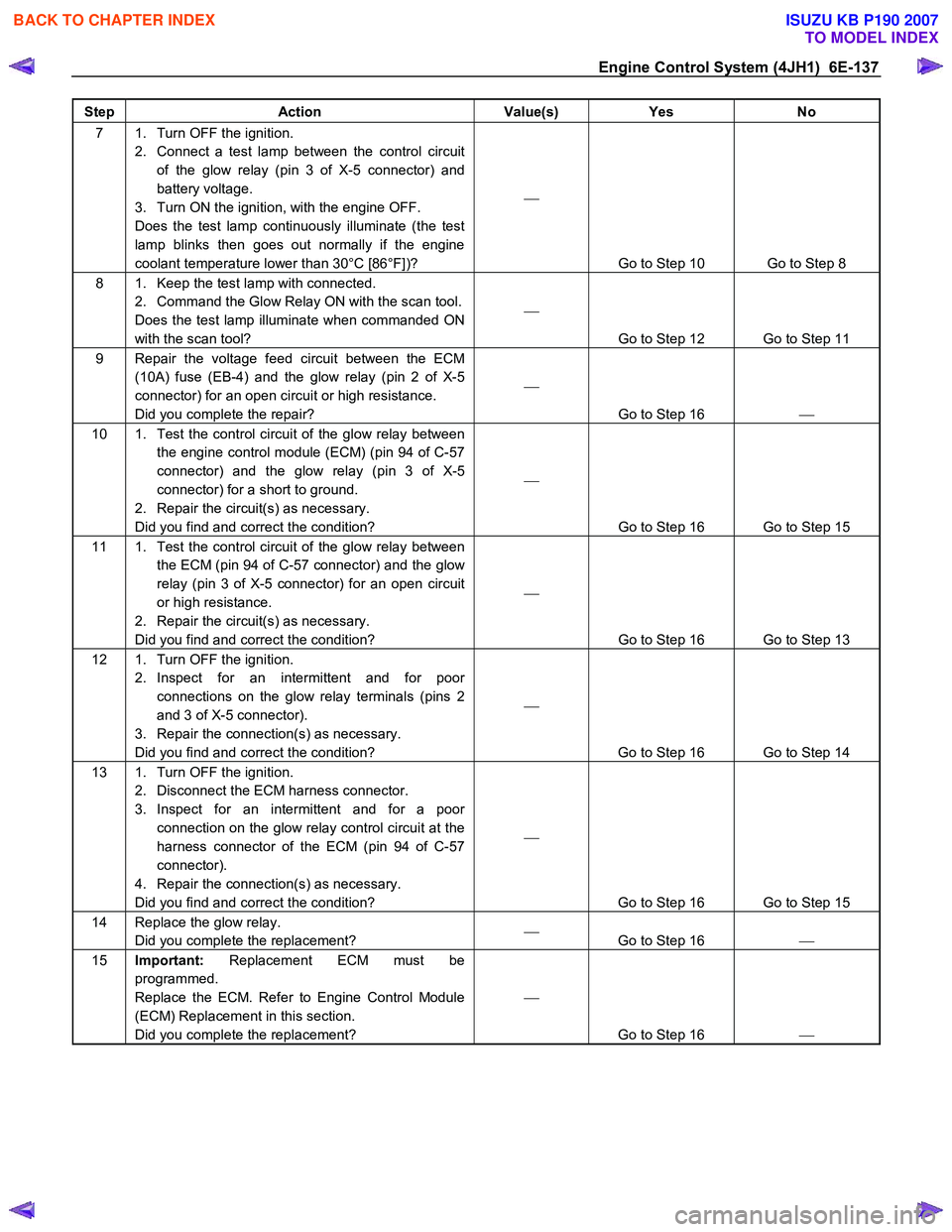
Engine Control System (4JH1) 6E-137
Step Action Value(s) Yes No
7 1. Turn OFF the ignition.
2. Connect a test lamp between the control circuit of the glow relay (pin 3 of X-5 connector) and
battery voltage.
3. Turn ON the ignition, with the engine OFF.
Does the test lamp continuously illuminate (the test
lamp blinks then goes out normally if the engine
coolant temperature lower than 30°C [86°F])?
Go to Step 10 Go to Step 8
8 1. Keep the test lamp with connected. 2. Command the Glow Relay ON with the scan tool.
Does the test lamp illuminate when commanded ON
with the scan tool?
Go to Step 12 Go to Step 11
9 Repair the voltage feed circuit between the ECM (10A) fuse (EB-4) and the glow relay (pin 2 of X-5
connector) for an open circuit or high resistance.
Did you complete the repair?
Go to Step 16
10 1. Test the control circuit of the glow relay between
the engine control module (ECM) (pin 94 of C-57
connector) and the glow relay (pin 3 of X-5
connector) for a short to ground.
2. Repair the circuit(s) as necessary.
Did you find and correct the condition?
Go to Step 16 Go to Step 15
11 1. Test the control circuit of the glow relay between the ECM (pin 94 of C-57 connector) and the glow
relay (pin 3 of X-5 connector) for an open circuit
or high resistance.
2. Repair the circuit(s) as necessary.
Did you find and correct the condition?
Go to Step 16 Go to Step 13
12 1. Turn OFF the ignition. 2. Inspect for an intermittent and for poor connections on the glow relay terminals (pins 2
and 3 of X-5 connector).
3. Repair the connection(s) as necessary.
Did you find and correct the condition?
Go to Step 16 Go to Step 14
13 1. Turn OFF the ignition. 2. Disconnect the ECM harness connector.
3. Inspect for an intermittent and for a poor connection on the glow relay control circuit at the
harness connector of the ECM (pin 94 of C-57
connector).
4. Repair the connection(s) as necessary.
Did you find and correct the condition?
Go to Step 16 Go to Step 15
14 Replace the glow relay. Did you complete the replacement?
Go to Step 16
15 Important: Replacement ECM must be
programmed.
Replace the ECM. Refer to Engine Control Module
(ECM) Replacement in this section.
Did you complete the replacement?
Go to Step 16
BACK TO CHAPTER INDEX
TO MODEL INDEX
ISUZU KB P190 2007